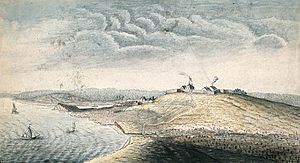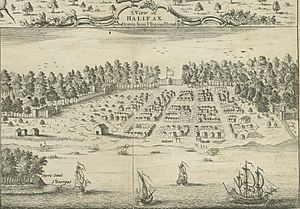Father Le Loutre's War facts for kids
Quick facts for kids Father Le Loutre's War |
|||||||
|---|---|---|---|---|---|---|---|
| Part of the Anglo-French Wars | |||||||
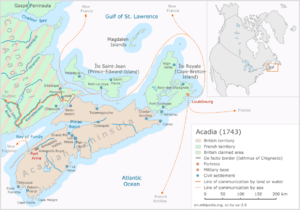 Map of Acadia, c. 1743. The conflict was primarily fought in Acadia. |
|||||||
|
|||||||
| Belligerents | |||||||
|
|||||||
| Commanders and leaders | |||||||
|
|
||||||
Father Le Loutre's War (1749–1755) was a conflict that happened in Acadia and Nova Scotia. It is also known by other names like the Indian War or the Mi'kmaq War. This war took place between two bigger conflicts: King George's War and the French and Indian War.
On one side, the British and settlers from New England were led by British officers like Charles Lawrence and a special soldier called a Ranger, John Gorham. On the other side, a French priest named Father Jean-Louis Le Loutre led the Mi'kmaq people and the Acadian militia. They fought using guerrilla warfare, which means they used surprise attacks and small groups instead of large armies.
Even though the British had captured Port Royal in 1710, the Mi'kmaq and Acadians still controlled most of the area. About 40 years later, the British wanted to settle more Protestant people in the region and take full military control. This made the Acadians and Mi'kmaq angry, leading to the war. The British brought 3,229 new settlers to Halifax in the first few years. This was more than the total number of Mi'kmaq people in the whole region, and it felt like a big threat to their traditional lands.
The war caused a lot of changes in the area. Many people moved, new forts were built, and more soldiers were sent. There were 24 recorded battles and raids during the war. Thirteen of these were Mi'kmaq and Acadian attacks on the Halifax/Dartmouth area. Many other smaller fights likely happened but were not written down.
During the war, the British tried to control the main Acadian towns in Nova Scotia and expand into what is now New Brunswick. They also wanted to create Protestant communities. Because of this, many Acadians and Mi'kmaq left Nova Scotia and moved to French-controlled islands like Ile St. Jean (Prince Edward Island) and Ile Royale (Cape Breton Island). The French also tried to keep control of New Brunswick. The Mi’kmaq and Acadians often attacked British forts and new settlements to slow down British expansion.
The war started when the British founded Halifax. The Acadians and Mi'kmaq responded with attacks in places like Chignecto, Grand Pré, Dartmouth, and Canso. The French built their own forts at Fort Menagoueche, Fort Beauséjour, and Fort Gaspareaux. The British fought back by attacking the Mi'kmaq and Acadians at Mirligueche (now Lunenburg), Chignecto, and St. Croix. The British also built forts in Acadian communities like Windsor, Grand Pré, and Chignecto. The war ended after six years when the British won the Battle of Fort Beauséjour.
Contents
How the War Started
Acadian resistance to British rule in Acadia began after Queen Anne's War. In 1713, the Treaty of Portsmouth was signed. This treaty gave parts of New France to the British, including the Hudson Bay region, Newfoundland, and the Acadian peninsula. Acadians had often supported the French in earlier conflicts. For example, during King William's War, Acadians helped French privateer Pierre Maisonnat dit Baptiste win battles against British ships.
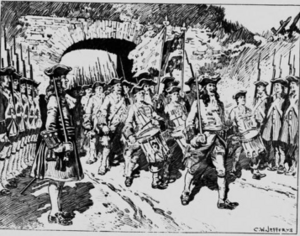
Even after the treaty, the British faced resistance from French settlers in Acadia. During Dummer's War, the Maliseet people attacked British ships in the Bay of Fundy. The Mi'kmaq also raided Canso in 1723, with help from the Acadians.
The French and Acadian settlers often fought alongside the Mi'kmaq. The Mi'kmaq were part of the Wabanaki Confederacy. They had a long history of defending their land by fighting British soldiers and settlers along the border between New England and Acadia.
Hostilities between the British and French started again during King George's War (1744–48). Father Jean-Louis Le Loutre led French soldiers, Acadians, and Mi’kmaq in attempts to recapture the capital, such as the Siege of Annapolis Royal. During this time, Le Loutre, Gorham, and Lawrence became important figures in the region. Even though the war ended with the Treaty of Aix-la-Chapelle in 1748, the British wanted to strengthen their control over Acadia. This led to more conflict with the Acadians and Mi'kmaq.
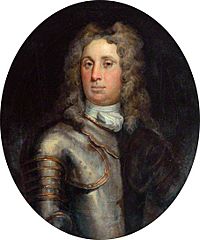
At the start of Le Loutre's War, the British had several regiments in Halifax, including the 40th, 29th Regiment of Foot, and 45th Regiment of Foot. The 47th Regiment arrived later. Captain John Rous was the main naval officer in the area.
The War Begins
1749: British Take Control
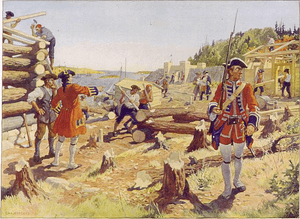
The war began when Edward Cornwallis arrived in Halifax on June 21, 1749, to establish a new settlement. The British quickly started building other towns and forts to protect them from Mi'kmaq, Acadian, and French attacks. Forts were built in Halifax (Citadel Hill in 1749), Bedford (Fort Sackville in 1749), Dartmouth (1750), Lunenburg (1753), and Lawrencetown (1754).
Within 18 months, the British tried to control the Nova Scotia peninsula by building forts in all the main Acadian communities. These included Fort Edward in Windsor, Fort Vieux Logis in Grand Pré, and Fort Lawrence in Chignecto. There was already a British fort (Fort Anne) in Annapolis Royal. Father Le Loutre reportedly said that the British could build as many forts as they wanted, but he would make sure they couldn't leave them, because he planned to "torment them with his Indians." Mi'kmaq resistance kept the British mostly stuck inside their forts until 1758.
By June 1751, Cornwallis wrote that his enemies had "done as much harm as they could have done in open war." Richard Bulkeley also wrote that between 1749 and 1755, Nova Scotia was "kept in an uninterrupted state of war by the Acadians."
The only land route between Louisbourg (a French fort) and Quebec went through Chignecto, along the Bay of Fundy, and up the Saint John River. When Halifax was built, the French saw it as a threat to Quebec City. To protect this important route, the French built three forts in 1749: one at Baie Verte (Fort Gaspareaux), one at Chignecto (Fort Beauséjour), and another at the mouth of the Saint John River (Fort Menagoueche).
The British also built forts along the Kennebec River in what is now Maine, including Fort Halifax, Fort Shirley, and Fort Western.
The Acadian Exodus
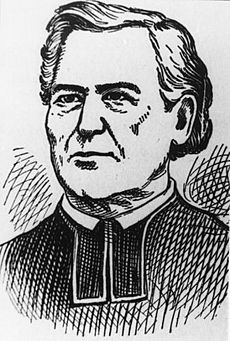
Many Acadians decided to resist the British. On September 18, 1749, 1,000 Acadians signed a document saying they would leave the country rather than sign an oath of loyalty to the British king without conditions. Cornwallis insisted on the oath, which would have meant giving up their Catholic faith. In response, hundreds of Acadians were forced out by the British. Their homes, lands, and cattle were taken. This event, called the Acadian Exodus, involved almost half of the Acadian population of Nova Scotia. Families were often separated. Father Jean-Louis Le Loutre was a key leader of this movement.
Early Conflicts
The first Mi'kmaq attack after the treaties was at Canso. On August 19, 1749, Mi'kmaq attacked a group of British men, taking 20 prisoners to Louisbourg. Sixteen prisoners were later released.
At Chignecto in August 1749, the Mi'kmaq attacked two British ships. On September 18, several Mi'kmaq and Maliseets ambushed and killed three British men at Chignecto. Seven natives were also killed.
On September 24, 1749, the Mi'kmaq formally wrote to Governor Cornwallis. They stated they owned the land and opposed the British settling in Halifax.
On September 30, 1749, about 40 Mi'kmaq attacked six men in Dartmouth. Four men were killed, one was captured, and one escaped. This was the first of eight attacks on Dartmouth during the war.
Cornwallis' Proclamation
On October 1, 1749, Governor Cornwallis and the Nova Scotia Council decided to treat the Mi'kmaq as rebellious subjects, not as an independent nation at war. They called them "Banditti Ruffians, or Rebels."
On October 2, 1749, the Nova Scotia Council issued a proclamation against the Mi’kmaq. It allowed British subjects to "annoy, distress, take or destroy" any Mi'kmaq. It also offered a reward of 10 guineas for every Mi'kmaq killed or captured. This was meant to stop native raids and force them to submit.
To do this, two companies of rangers were formed, led by Captain Francis Bartelo and Captain William Clapham. These companies, along with John Gorham's, searched for Mi'kmaq around Halifax. On October 5, Cornwallis sent troops to Mirligueche (Lunenburg).
After two more attacks in June 1750, Cornwallis increased the bounty to 50 guineas on June 21, 1750. However, during his time as governor, there is no evidence of prisoners being taken, and only three non-combatants (young people) were killed in 1752.
Siege of Grand Pré
On November 27, 1749, 300 Mi'kmaq, Maliseet, and Acadians attacked Fort Vieux Logis in Grand Pré. They killed the guards and captured Lieutenant John Hamilton and 18 soldiers. The native and Acadian militias tried to besiege the fort for a week before leaving with their prisoners. Gorham's Rangers were sent to help, but the attackers had already left. The prisoners were held for several years before being released.
1750–1751: Continued Fighting
Battle at St. Croix
In the spring of 1750, on March 18, John Gorham and his Rangers marched to Piziquid (now Windsor, Nova Scotia). Their mission was to build a blockhouse, which became Fort Edward. They also seized property from Acadians who had been involved in the siege of Grand Pré.
On March 20, Gorham's men found the Acadian village of Five Houses deserted. They saw Mi’kmaq hiding across the St. Croix River and opened fire. The fight turned into a siege, with Gorham's men taking cover in a sawmill. Gorham himself was wounded. Reinforcements arrived on March 22, forcing the Mi’kmaq to retreat.
Gorham then made Acadians dismantle their church so that Fort Edward could be built in its place.
Battles at Chignecto
In May 1750, Lawrence tried to establish a fort at Chignecto, but Father Le Loutre burned the village of Beaubassin to prevent the British from using its supplies. Lawrence retreated but returned in September 1750.
On September 3, 1750, John Gorham led over 700 men to the Isthmus of Chignecto. Mi’kmaq and Acadians resisted, killing 20 British soldiers. The Mi’kmaq were eventually overwhelmed and retreated, burning their crops and houses. On October 15, a group of Mi'kmaq disguised as French officers tricked and seriously wounded British official Edward How, who died days later.

Le Loutre and Acadian leader Joseph Broussard fought against the British. The British won and began building Fort Lawrence near the ruined village of Beaubassin. To stop the British from expanding further, the French also built Fort Beauséjour and two smaller forts: Fort Gaspareaux and Fort Menagoueche.
During these months, 35 Mi'kmaq and Acadians ambushed Ranger Francis Bartelo, killing him and six of his men, and capturing seven others.
Raids on Halifax
Halifax was attacked four times during the war. The first raid happened in October 1750.
In 1751, Mi'kmaq attacked two blockhouses (small forts) around Halifax, killing the guards. They also attacked a saw-mill, killing two men.
In August 1750, a naval battle took place off Baie Verte. British Captain Le Cras captured a French ship, the London. It was found to be carrying weapons and supplies from Quebec for Le Loutre and the Mi'kmaq fighters. This showed the French were helping the Mi'kmaq.
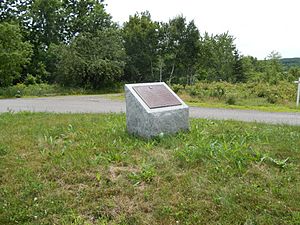
In September 1750, French officer Louis Du Pont Duchambon de Vergor was transporting supplies to Boishebert at Fort Boishebert. On October 16, British Captain John Rous in HMS Albany attacked Vergor's ships. Vergor fought bravely, allowing one supply ship to escape. His ship was badly damaged and he surrendered. This was the second time the British caught the Governor of Canada sending military supplies to the Mi'kmaq.
Raids on Dartmouth
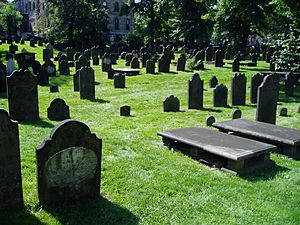
Dartmouth was attacked six times during this period. In July 1750, Mi'kmaq killed seven men working in Dartmouth.
In August 1750, 353 new settlers arrived and started the town of Dartmouth. On September 30, 1750, Dartmouth was attacked again, and five more residents were killed. In October 1750, a group of eight men were captured while hunting.
On March 26, 1751, the Mi'kmaq attacked again, killing 15 settlers and wounding seven. They took six captives. Two days later, on March 28, three more settlers were captured.
On May 13, 1751, Joseph Broussard led 60 Mi'kmaq and Acadians to attack Dartmouth again. This was known as the "Dartmouth Massacre." They killed 20 settlers and took more prisoners. A sergeant was also killed. The attackers destroyed buildings. The British reported killing six Mi'kmaq warriors. The bodies of the British victims were taken to Halifax for burial.
Raid on Chignecto
The British responded to the Dartmouth raid by sending armed groups to Chignecto. They killed some French defenders and broke the dikes, ruining hundreds of acres of crops. This was a disaster for the Acadians and French troops. Father Le Loutre went to Quebec and France to get help rebuilding the dikes.
1752–1753: Shifting Tides
In 1752, Mi'kmaq attacks on British settlements along the coast were frequent. Fishermen had to stay on land because they were often targeted. In August, at St. Peter's, Nova Scotia, Mi'kmaq captured two ships and 21 prisoners, who were later ransomed.
By summer 1752, the war was not going well for the British. The Acadian Exodus continued, and the colony was running out of money. Two of the three main ranger leaders had died or left. To save money, the ranger companies were reduced to just one. This led to a new rule in March 1753, requiring all British subjects aged 16 to 60 to serve in a local militia for defense.
On September 14, 1752, Governor Peregrine Hopson and the Nova Scotia Council tried to make peace by signing the Treaty of 1752 with Mi'kmaq Chief Jean-Baptiste Cope. However, Cope could not get other Mi'kmaq leaders to support the treaty, and he burned it six months later.
Attack at Mocodome
On February 21, 1753, nine Mi'kmaq attacked a British ship from Canso at Country Harbour. They killed two British crew members and took two others captive. After seven weeks, on April 8, the two British prisoners killed six Mi'kmaq and escaped.
Attack at Jeddore
In response, on May 19, Chief Jean-Baptiste Cope and the Mi'kmaq attacked another British ship off Jeddore, Nova Scotia. They killed the nine British men on board and let the Acadian pilot go. The Mi'kmaq then looted and sank the ship.
Raid on Halifax
In 1753, when Lawrence became governor, the Mi'kmaq attacked sawmills near Halifax again, killing three British. In Dartmouth, only five families remained, and they were too afraid to farm outside the village's protective fence. Governor Hobson reported in July 1753 that they were in "continual war with the Indians."
The Lunenburg Rebellion
In spring 1753, the British planned to establish a new settlement in Lunenburg without talking to the Mi'kmaq. This went against an earlier treaty. Governor Peregrine Hopson was warned that 300 natives were ready to attack the new settlers. The British wanted to settle Protestants in Nova Scotia to balance the Catholic Acadians. They also wanted to move some unhappy German Protestants from Halifax.
In June 1753, 1,400 German and French Protestant settlers, protected by the British Navy and soldiers, established Lunenburg. The settlement was founded by British officers John Creighton and Patrick Sutherland, and a German official Dettlieb Christopher Jessen.
In December 1753, just six months after arriving, the new settlers in Lunenburg, who were mostly German Protestants, rebelled against the British. They were tired of the poor conditions. This rebellion, led by John Hoffman, is called "The Hoffman Insurrection." Hoffman led a group that locked up the Justice of the Peace and some soldiers. The rebels then declared their own "republic."
Commander Patrick Sutherland asked for help from Halifax. Lawrence sent Colonel Robert Monckton with troops to restore order. Monckton arrested Hoffman, who was accused of planning to join the French and take settlers with him. Hoffman was fined and imprisoned for two years.
After the rebellion, some French and German-speaking Protestants left Lunenburg to join Father Le Loutre and the Acadians. Lawrence refused to send Acadians to the area, fearing their influence on the local population.
Dyking on Riviere Au Lac
Father Le Loutre and the Acadian refugees at Chignecto worked hard to build dikes to support their new communities. Acadians from Minas helped by providing food and labor. After the Raid on Dartmouth (1751), the British attacked Chignecto, destroying the dikes and ruining crops. Some Acadians started to leave the exodus and wanted to return to the British colony. Le Loutre got help from Quebec and France to rebuild the dikes. Work began in May 1753 on the large dyking project on Riviere Au Lac (now Aulac River). At this time, there were 2,000 Acadians and about 300 Mi'kmaq nearby.
By summer 1754, Le Loutre had a large workforce of 1,400 to 1,500 Acadian men. Nearby, there was a summer camp of about 400 natives. This gave him a strong fighting force. However, that year, storm tides broke through the main dike, destroying almost everything the Acadians had built. Again, some Acadians tried to go back to the British.
1754–1755: Final Years of Conflict
Raid on Lawrencetown
In 1754, the British established Lawrencetown. In April 1754, Joseph Beausoleil and a large group of Mi'kmaq and Acadians attacked the village. They killed four British settlers and two soldiers. By August, the remaining residents and soldiers were moved to Halifax because of the ongoing raids. By June 1757, the settlement of Lawrencetown had to be completely abandoned because of the constant native attacks.
A well-known Halifax businessman, Michael Francklin, was captured by a Mi'kmaq raiding party in 1754 and held for three months.
Port Joli
In 1754, a canoe full of Mi'kmaq fighters tried to damage a New England fishing vessel. The New England crew sank the canoe, and all the Mi'kmaq drowned except one woman, Molly Pigtow, who was captured and taken to New England.
Battle off Port La Tour (1755)
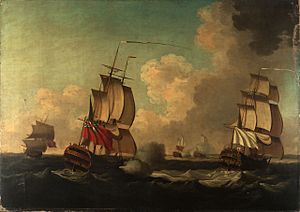
In April 1755, while searching for a wrecked ship at Port La Tour, Cobb found the French ship Marguerite, which was carrying war supplies to the Saint John River for Boishebert at Fort Menagoueche. Cobb reported this to Governor Charles Lawrence, who ordered him to block the harbor until Captain William Kensey arrived to capture the French ship.
In a naval battle on June 8, 1755, off Cape Race, Newfoundland, the British found 10,000 scalping knives on board the French ships Alcide and Lys. These were meant for the Acadians and Indians fighting under Mi'kmaq Chief Cope and Acadian Beausoleil in Father Le Loutre's War. This battle helped lead to the start of the Seven Years' War.
Battle of Fort Beauséjour
On May 22, 1755, the British sent a fleet of three warships and 33 transport ships carrying 2,100 soldiers from Boston. They landed at Fort Lawrence on June 3, 1755. The next day, the British forces attacked Fort Beauséjour. After the fort surrendered on June 16, 1755, the French forces left for Fort Gaspereaux and then Louisbourg. Soon after, the British captured Fort Menagoueche at the mouth of the St. John River. Boishebert, seeing that he couldn't win, destroyed the fort himself and retreated upriver. This battle was a major British victory in the Seven Years' War, helping Great Britain gain control of most of New France.
Trade During the War
During Father Le Loutre's War, the communities in the Minas Basin helped Le Loutre by providing food. They grew wheat and other grains, produced flour, and raised thousands of cattle, sheep, and hogs. Cattle were regularly driven from Cobequid to Tatamagouche to supply Fort Beauséjour, Louisbourg, and settlements on Ile St. Jean. Other goods were sent by sea from Minas Basin to Beaubassin or the Saint John River by Acadian traders.
At the same time, Acadians started refusing to trade with the British. By 1754, no Acadian produce was reaching the Halifax market. Even when British merchants tried to buy directly from Acadians, they were refused. Acadians also refused to supply Fort Edward with firewood. Lawrence passed a law forbidding Acadian exports until the Halifax market was supplied. The British developed a war plan for Nova Scotia that focused on cutting off food supplies to Fort Beauséjour and Louisbourg.
Aftermath
Father Le Loutre's War had become a "total war," meaning that British civilians were also targeted. Lawrence believed that Acadian civilians were helping the enemy by providing information, shelter, and supplies, and some even fought.
The biggest problem for French power in the region was the lack of supplies. To cut off supplies to the French, Lawrence realized he could do this by deporting the Acadians.
After Fort Beauséjour fell, Le Loutre was imprisoned, and the Acadian expulsion began. During the French and Indian War, British forces gathered French settlers, starting with the Bay of Fundy Campaign (1755). The British deported the Acadians and burned their villages to prevent them from returning.
The Acadians who joined the Acadian Exodus during the war, especially those who went to Ile St. Jean and Ile Royale, were mostly spared from the British expulsion of the Acadians in 1755. However, after the fall of Louisbourg in 1758, these Acadians were also deported.
Images for kids




